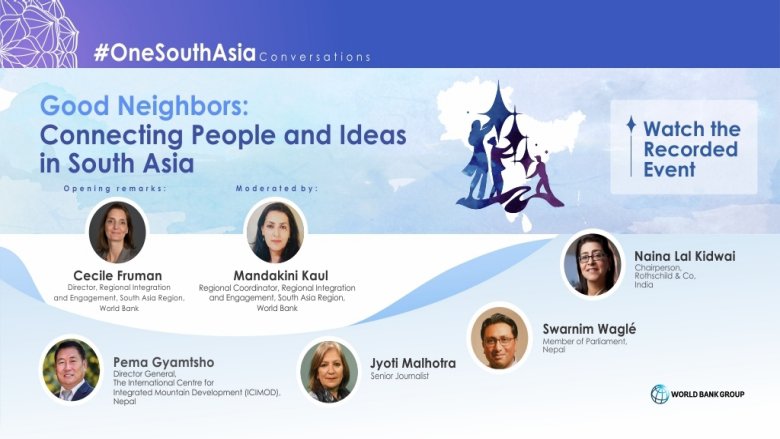This is a recorded event.
Also, watch here the Fire Side Chat with Ambassador Shyam Saran, Chairperson, India International Centre and Cecile Fruman, Director, Regional Integration, World Bank.
About the Event: Our 18th #OneSouthAsia Conversation was held in partnership with the India International Center, New Delhi, where we brought together prominent South Asian voices to discuss ways to strengthen people-to-people connectivity and ideas across borders. This Conversation builds on our report, Good Neighbours: Advancing Regional Integration, Cooperation and Engagement in South Asia, which showcases successful cross-border stories that promote understanding, trust, and people-to-people contacts. This is the recorded version of the panel discussion.
Background: South Asia is one of the least integrated regions globally in terms of trade and connectivity. The intraregional trade is barely 5% of the region’s total trade. In comparison, intraregional trade share is about 60% of the total trade in Europe, 50%in East Asia and Pacific, 22 % in Sub-Saharan Africa, 25% in the Association of Southeast Asian Nations (ASEAN). The average costs of trade within South Asia are 20 % higher relative to country pairs in the ASEAN. Given the high connectivity and trade costs, for an Indian company, it is 15-20 % less expensive to trade with Brazil or Germany than with Bangladesh.
As we analyse the low levels of intra-regional cooperation in South Asia and highlight how trade, connectivity, and infrastructure linkages are amongst the lowest in the world, we often overlook the small but significant ways in which people of the region come together, with a great deal of innovation and fortitude and mostly in the face of significant barriers. For example, since the last 20 years, hundreds of undergraduate students have convened annually at the South Asia Economics’ Student Meet to exchange academic research, and to build lasting bonds and friendships, or a South Asian symphony orchestra, or cooperation amongst scientists to address the effects of climate change. These are all small but effective examples of cooperation.
This discussion builds on such examples and explore future pathways of people-to-people connectivity, and what will it take to connect people across borders.






